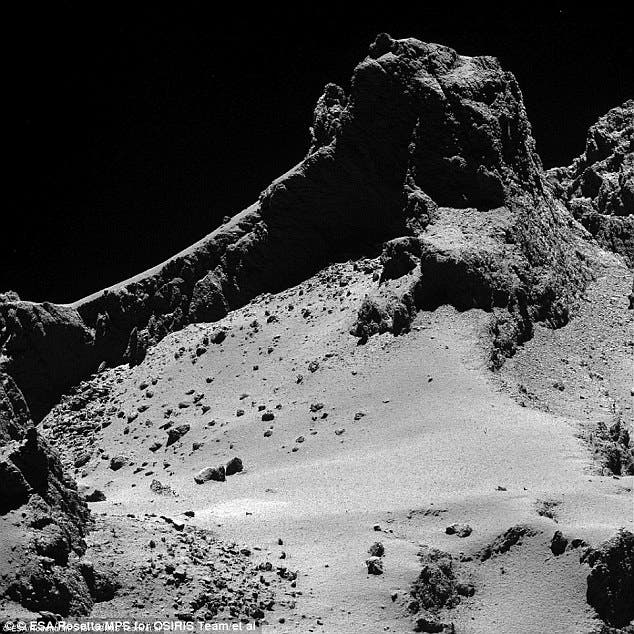Comet lander Philae may be sitting on top of microbial life and not even know it – even worse, it has no way of figuring out if it actually is. According to two researchers, the comet’s characteristics (as well as computer simulations) might indicate that the surface may be teeming with microbes.
The Rosetta spacecraft was launched in March 2004 by the European Space Agency (ESA). Along with Philae, its lander module, its main goal was to perform a detailed study of comet 67P/Churyumov–Gerasimenko (67P); this was actually the first mission to orbit and study a comet up close. In late 2014, Philae successfully landed on a comet and obtained detailed images of the comet’s surface. On 15 November 2014, Philae entered its hibernation mode after its batteries ran down due to reduced sunlight, but in June 2015, Philae woke up and started communicating again, sending some important clues regarding potential alien life on the comet.
The comet has a black, organic-rich crust, which could with organisms making their way beneath its icy surface. Of course, there are other (more reasonable) explanations, but researchers seem adamant in their claims. If there is in fact life on comet 67P, then it would be nothing more than microbes, but these microbes would be huge (figuratively, not literally) – it would be mind boggling, which is why so many are skeptical about these claims.
Director of the Buckingham Centre for Astrobiology professor Chandra Wickramasinghe and his colleague Dr Max Wallis from the University of Cardiff have said that comet 67P and others like it may have significant populations of extremophiles on it – organisms that can survive in extreme conditions, like the ones on 67P.
“These are not easily explained in terms of prebiotic chemistry. The dark material is being constantly replenished as it is boiled off by heat from the sun. Something must be doing that at a fairly prolific rate,” Wickramasinghe said.

The comet has a black hydrocarbon crust overlaying ice, smooth icy ‘seas’, and flat-bottomed craters containing ‘lakes’ of re-frozen water overlain with organic debris.
To make things even more tantalizing, Wickramasinghe and Wallis conducted computer simulations which showed that it would be (theoretically) possible for microbes to survive on the comet. The astronomers present their case for life on 67P at the Royal Astronomical Society’s National Astronomy Meeting in Llandudno, Wales. Now, scientists are kicking themselves for not adding life-detection technology to Philae.
“I wanted to include a very inexpensive life-detection experiment. At the time it was thought this was a bizarre proposition,” Wickramasinghe added.
Furthermore, several cracks in the ice had been shown to be ‘spewing out material’ that is falling on to the surface, which also points to microbial activity.
“I think the microbiotic activity just under the surface results in gas which builds up to the point where the overlaying layers of ice can’t withstand the stresses,” said the professor.
If this were actually the case, if life actually exists on comet, it would be huge – potentially force us to rethink what we know about the very emergence of life. It also has vast implications for life on Earth; would life on Earth evolved by itself, or would have it been “seeded” by comets? But as strange and difficult to accept this may be, we have to keep an open mind.
“Five hundred years ago it was a struggle to have people accept that the Earth was not the center of the universe. After that revolution our thinking has remained Earth-centered in relation to life and biology. It’s deeply ingrained in our scientific culture and it will take a lot of evidence to kick it over,” Wickramasinghe said.










